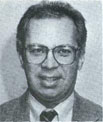|

|
TRAFFIC CONTROL DEVICES
How Well Are They Understood — And Observed?
By WILLIAM T. SUNLEY, Engineer of Local Roads and Streets
|
Traffic control devices are a vital element in the
highway environment. The Manual on Uniform Traffic
Control Devices contains principles that govern the
design and application of these devices. The signs and
markings in the manual use shape, color, symbols and
words to convey information needed by the driver. But
how well are these traffic control devices understood
and obeyed by the motoring public?
A recent study analyzed motorist understanding of a
number of traffic signs and pavement markings. This
study, conducted by H. Gene Hawkins, Jr., Katie N.
Womack and John M. Mounce, tested the comprehension of traffic control devices by approximately 1800
drivers. The study was limited to selected regulatory
signs, warning signs and pavement markings. Those
participating were shown a video of each sign or marking at locations where they are normally placed, along
with a close-up view. Motorists answered multiple
choice questions for each device.
The study determined that comprehension levels
for regulatory signs ranged between 15 and 93 percent.
For warning signs, the comprehension rate was between 29 and 89 percent and for pavement markings,
the comprehension rate was between 50.3 and 88.0.
|
|
Percent
Comprehension
|
|
SPEED ZONE AHEAD
|
55.0
|
|
Two-way Left-Turn Lane
|
44.6
|
|
Turn
|
31.9
|
|
Railroad Advance Warning
|
77.8
|
|
Single Broken Yellow Center Line
|
76.8
|
|
No Passing Zone Markings
|
88.0
|
|
The authors believe that the correct response rate
for a given device should not necessarily be equated
with the effectiveness of the traffic control device. Yet
one cannot help but wonder how well motorists understand and respond to these devices when their comprehension is so low in a survey.
Perhaps an even more revealing survey appeared in
the March 1990 edition of Public Roads, Martin T.
Pietrucha, Richard L. Knoblauch, Kenneth S. Opiela
and Kristy Criger analyzed motorist compliance with
several traffic control devices. Some of these results are
as follows:
|
|
In view of these findings, one could conclude that
careful placement, operation and maintenance of traffic control devices does not necessarily insure understanding or compliance. The 3 "E's" of traffic engineering are engineering, education and enforcement. A
weakness in any of these areas diminishes the total. •
Credits to: Leiand Bates, Local Policy & Procedures Engineer
|
|
Non-compliant Behavior
|
Percent Violation
|
|
Running the Red Light
|
0.9
|
|
Failure to Come to a Complete Stop at a STOP sign
|
67.6
|
| Right Turn on Red after Stopping
|
61.3
|
|
|
NOTICE
Governor Jim Edgar's Fiscal Year 1996 budget
proposed $5 billion for transportation that emphasizes the repair and preservation of the state's road
and public transportation systems.
A major effort included in the budget message
will be continuation of special assistance programs
for local governments. These programs include
aiding municipalities and counties that are experiencing high growth, providing special help to
counties suffering decreased property tax evaluations and aiding needy counties and townships
with repairs to their road systems.
A total of $23 million in these special programs
was to expire in Fiscal 1994 but a one year continuance was provided for 1995. The programs are
being extended again for Fiscal 1996. Further extensions of these programs will depend on the ability to maintain a highway construction program at
the existing level.
|
April 1995 / Illinois Municipal Review / Page 19
|